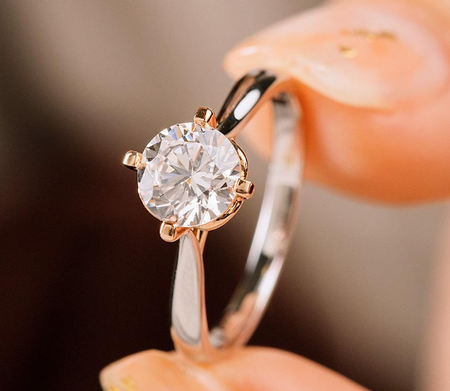These 4 Cs were first developed by the Gemological Institute of America (GIA) to form the basis of how diamonds are gemologically certified. They are: Clarity, Carat, Color and Cut. You can read more about them below.
Clarity
When determining the clarity of a diamond, the presence of both internal and external irregularities must be assessed. Internal irregularities are known as inclusions and external ones as blemishes. The assessment takes into account not only the amount of these blemishes or inclusions, but also their characteristics, such as color, location, size, and nature. These imperfections are invisible to the naked eye, but can be viewed through a 10x magnifying glass. Afterwards, the diamond will be ranked on the GIA Clarity Scale:
– flawless
– internally flawless (if)
– very very slightly included (VVS1, VVS2)
– very slightly included (VSI1, VSI2)
– Slightly inclusive (SI1, SI2)
– Included (I1, I2, I3)
Flaw is the most valuable of diamonds with absolutely zero intrusions or blemishes, while I3 is the least valuable for investment purposes with many different flaws.
Carat
Carat scales are used to measure the weight of diamonds. The word carat comes from ancient times when people used the seeds of the kalob tree to balance the scales.
As you can imagine, the more carats a diamond has, the more valuable it is for investment purposes. One carat translates to 200 milligrams, although when discussing carats they are often standardized to a 100-point system. For example, a 0.7 carat diamond is worth 70 points.
However, as mentioned earlier, investing in diamonds can be tricky in certain situations.
Here's an example: If you have 2 identical diamonds weighing 0.98 carats and 0.99 carats, the value of the 0.99 carat diamond will increase by 1%. However, let's say you then have a third diamond, which is again close to the same, but at 1.00 carats, it could be worth as much as 20% more than the 0.99 carat one.
This is because of the human element of buying diamonds. Someone will pay a premium for a 1 carat diamond because they can claim and have proof that it is 1 carat whereas if you buy a 0.99 carat diamond you can never honestly claim it is 1 carat. These sudden spikes in value occur at multiple points on the diamond investment pricing scale, such as around 0.3, 0.5 and 0.7 carats.
Color
Much like clarity, a diamond's color is arranged on a scale known as the GIA color scale. It applies to the following system, with D being the clearest and most valuable and Z being the least valuable. – Colorless (D, E, F) – Nearly colorless (G, H, I, J) – Light (K, L, M) – very light (N, O, P, Q, R) – Light (S, T, U, V, W, X, Y, Z) This scale is for colorless diamonds. Of course, diamonds can come in different colors, such as yellow, black or blue, which can affect their willingness to invest. Therefore, GIA scales are only used for colorless diamonds, and colored diamonds are usually more valuable.
Cut
The cut of a diamond is the only part of the investment valuation process that is influenced by human factors. All other aspects depend on nature and how they have been formed over thousands of years.
The cut of a diamond determines how it reacts to light and how beautiful it will appear to the human eye once it is finished. Diamonds come in many different common designs, each of which will have a different way of manipulating the following three areas.
- Fire – This is how white light scatters into many different colors
- Brightness – the brightness of reflected light both internally and externally.
- Scintillation – Reflections within the diamond create a pattern of dark and light areas.
- The final proportions and finish of the diamond will affect how light affects the diamond and its final beauty.
Some common diamond cuts include:
- round
- Marquis
- pear
- Emerald
- Asher
- Pads
- princess
- Oval



0 comments